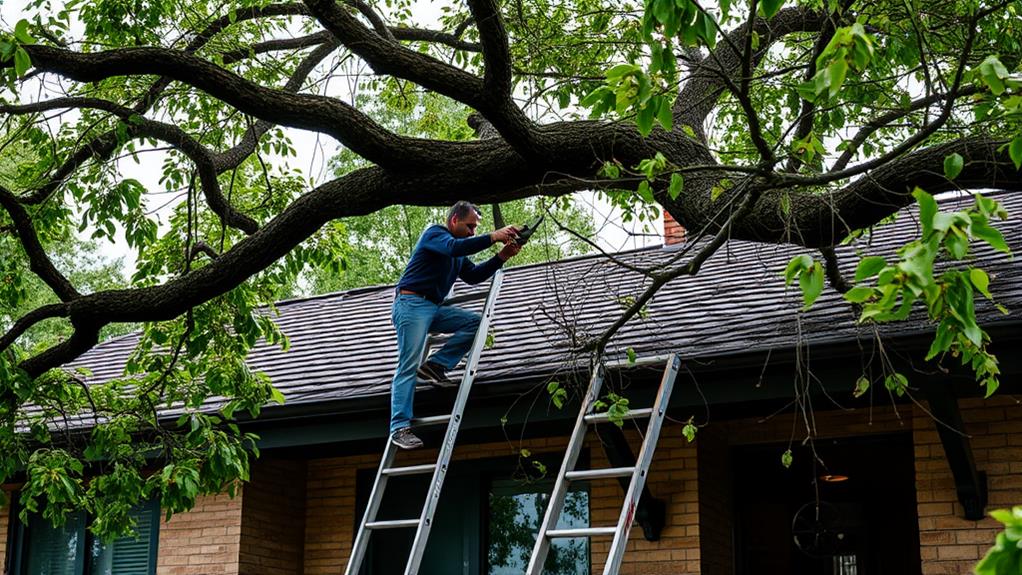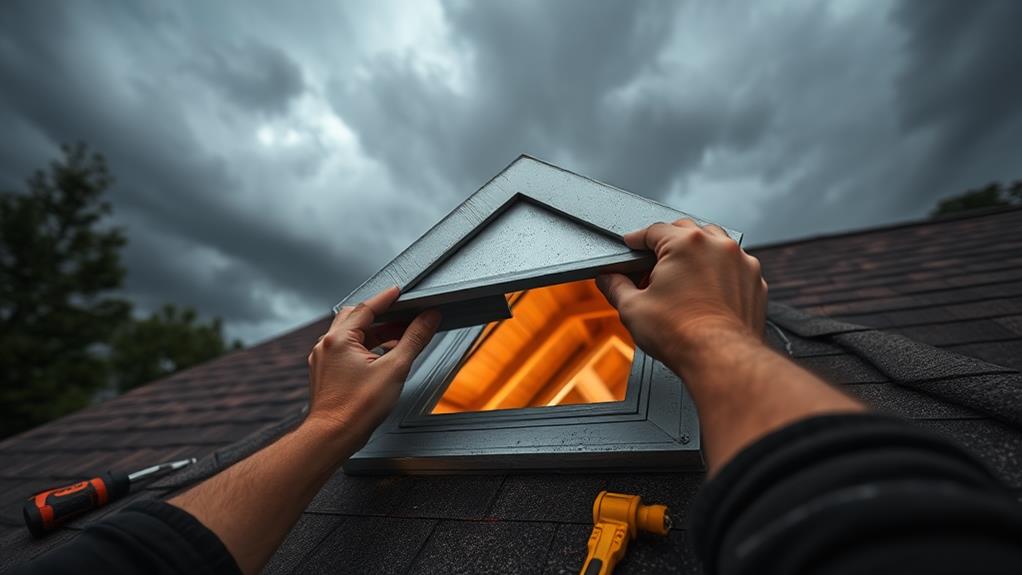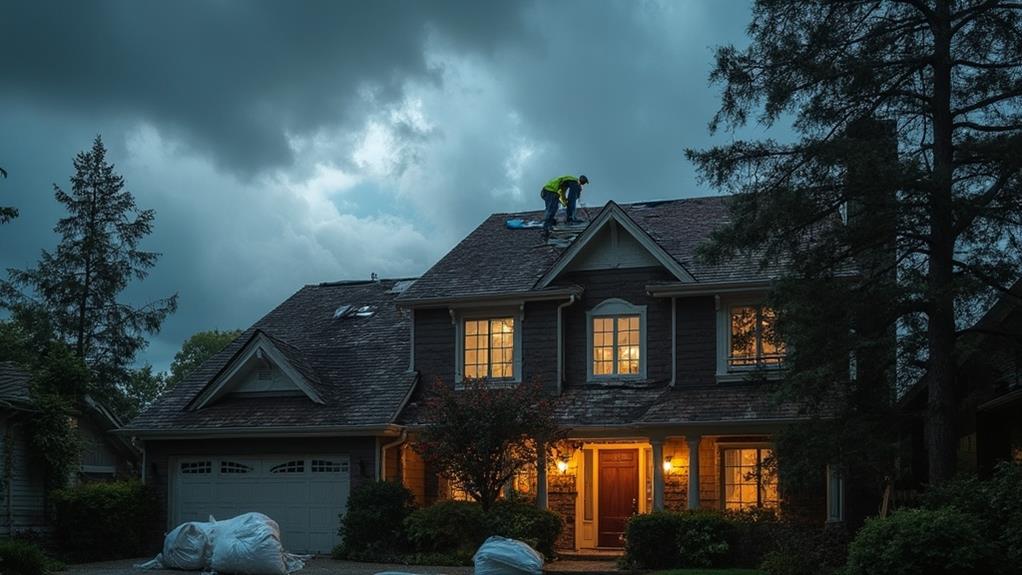Protecting your roof from storm damage involves regular inspections and proactive maintenance. Start by visually examining your roof for signs of wear or damage. Clear gutters and downspouts to ensure proper water drainage. Trim overhanging tree branches to reduce the risk of impact during high winds. Secure any loose shingles and reinforce attic ventilation to prevent wind-driven rain from entering. Consider installing impact-resistant roofing materials for enhanced protection against hail and debris. By implementing these pre-storm preparations, you can significantly improve your roof's resilience to severe weather conditions. Discover more ways to safeguard your home's first line of defense against the elements.
Inspect Your Roof Regularly

Regularly inspecting your roof is a crucial step in pre-storm preparations. This proactive measure allows homeowners to identify and address potential issues before they escalate during severe weather. Conduct visual inspections from the ground using binoculars, or hire a professional roofer for a more thorough examination.
Look for signs of damage or wear, including missing, cracked, or curling shingles, loose flashing around chimneys and vents, and sagging areas. Check gutters and downspouts for proper attachment and clear any debris to ensure proper water drainage. Inside the home, inspect the attic for signs of water stains, mold, or daylight penetrating through the roof.
Establish a routine inspection schedule, ideally twice a year – in spring and fall – and after any significant weather events. Keep detailed records of inspections and any repairs made, as this information can be valuable for insurance claims and future maintenance planning. By regularly assessing your roof's condition, you can identify and address vulnerabilities early, significantly reducing the risk of major damage during storms and prolonging the life of your roof.
Clear Gutters and Downspouts
Clear gutters and downspouts play a vital role in protecting your roof and home during storms. These components form a crucial drainage system that directs water away from your roof and foundation. When clogged with leaves, twigs, and debris, gutters and downspouts can cause water to back up and potentially seep under shingles, leading to leaks and water damage.
To maintain this system, clean your gutters at least twice a year, ideally in spring and fall. For homes surrounded by trees, more frequent cleaning may be necessary. Use a sturdy ladder and wear gloves to remove debris by hand or with a small trowel. Flush the gutters with water to ensure proper flow and check for any leaks or damaged sections.
Pay special attention to downspouts, ensuring they're securely attached and free from blockages. Extended downspouts should direct water at least three feet away from your home's foundation. Consider installing gutter guards to reduce debris accumulation and minimize maintenance. By keeping your gutters and downspouts clear and functional, you significantly reduce the risk of water-related damage during heavy rains and storms, protecting both your roof and your home's structural integrity.
Trim Overhanging Tree Branches

Looming over your roof, overhanging tree branches pose a significant threat during storms. These branches can scrape against shingles, causing damage and potentially compromising the roof's integrity. In severe weather conditions, they may break off and fall onto the roof, leading to punctures, dents, or even structural damage.
To mitigate these risks, regularly trim tree branches that extend over your roof. Aim to maintain a clearance of at least 10 feet between branches and your roof's surface. This buffer zone helps prevent direct contact during high winds and reduces the likelihood of falling debris.
When trimming, focus on removing dead, diseased, or weakened branches first, as these are most prone to breaking. Use proper pruning techniques to ensure clean cuts and minimize stress on the trees. For larger or hard-to-reach branches, consider hiring a professional arborist to safely complete the task.
Secure Loose Shingles
Loose shingles on your roof can quickly become a major problem during a storm. High winds can lift and tear off unsecured shingles, leaving your roof vulnerable to water damage and further deterioration. To prevent this, inspect your roof regularly for any signs of loose or damaged shingles, especially before an anticipated storm.
If you spot loose shingles, secure them immediately. Use roofing cement or adhesive to reattach the shingles to the roof deck. Apply a generous amount under the loose edges and press firmly. For severely damaged or missing shingles, replace them entirely with new ones that match your existing roof.
When securing shingles, pay special attention to the edges and corners of your roof, as these areas are particularly susceptible to wind damage. Ensure that all shingles are properly aligned and overlapping correctly to maintain a watertight seal.
If you're uncomfortable working on your roof or if the damage is extensive, consider hiring a professional roofing contractor. They can perform a thorough inspection and make necessary repairs to ensure your roof is storm-ready. Remember, addressing loose shingles proactively can save you from costly repairs and potential interior damage in the long run.
Reinforce Attic Ventilation

Proper attic ventilation plays a crucial role in protecting your roof during severe weather. It helps regulate temperature and moisture levels, preventing damage to your roof structure and shingles. Before a storm, inspect and reinforce your attic ventilation system to ensure it can withstand high winds and heavy rain.
Start by examining your roof vents, soffit vents, and ridge vents for any signs of damage or weakness. Replace any damaged components and securely fasten loose vents. Consider installing storm-resistant vent covers or baffles to prevent wind-driven rain from entering your attic space.
Ensure that your attic ventilation system is balanced, with an equal amount of intake and exhaust vents. This balance helps maintain proper airflow and prevents pressure buildup during storms. Clean any debris from vents and check that insulation is not blocking airflow.
For added protection, consider installing hurricane straps or clips to secure roof trusses and rafters to the walls. This reinforcement helps maintain the integrity of your roof structure during high winds. By taking these steps to reinforce your attic ventilation, you'll significantly improve your roof's ability to withstand severe weather conditions.
Install Impact-Resistant Roofing Materials
For enhanced protection against severe weather, installing impact-resistant roofing materials is a wise investment. These materials are specifically designed to withstand high winds, hail, and flying debris during storms. Impact-resistant shingles are typically made from strong polymers or reinforced with fiberglass, providing superior durability compared to traditional asphalt shingles.
When selecting impact-resistant roofing materials, look for products that meet UL 2218 or FM 4473 standards, which indicate the highest level of impact resistance. Class 4 rated materials offer the best protection against hail and wind-driven projectiles. Some popular options include metal roofing, synthetic slate, and specially engineered asphalt shingles.
Installing these materials may require professional expertise to ensure proper application and maximum effectiveness. While the initial cost might be higher than standard roofing materials, the long-term benefits often outweigh the investment. Impact-resistant roofs can potentially reduce insurance premiums, minimize storm damage, and extend the overall lifespan of your roof. Additionally, many manufacturers offer warranties of up to 50 years for these products, providing added peace of mind for homeowners in storm-prone areas.
Frequently Asked Questions
How Often Should I Have a Professional Roof Inspection?
Professional roof inspections are typically recommended annually, though some experts suggest twice a year—in spring and fall. However, homeowners should also schedule inspections after severe weather events or if they notice any visible damage or leaks.
Can I Apply Roof Sealant Myself to Prevent Leaks?
Picture a watertight shield protecting your home. While DIY roof sealant application is possible, it's a risky endeavor. Professional expertise ensures proper application, identifies underlying issues, and guarantees lasting protection. Consider hiring a roofing expert for optimal results.
What's the Best Way to Remove Moss and Algae From My Roof?
To remove moss and algae from your roof, use a specialized roof cleaner or a mixture of water and bleach. Apply the solution with a low-pressure sprayer, allow it to sit, then gently rinse. Avoid high-pressure washing to prevent damage.
Are There Specific Insurance Policies for Storm-Related Roof Damage?
When the storm clouds gather, it's wise to be prepared. Many insurers offer specific policies for storm-related roof damage, often as add-ons to standard homeowners insurance. These policies typically cover wind, hail, and debris damage.
How Do I Know if My Roof Is Too Old for Storm Protection?
To determine if your roof is too old for storm protection, consider its age, condition, and material type. Generally, roofs over 20 years old may be less resilient. Schedule a professional inspection to assess your roof's storm readiness.
Conclusion
The fortress of a home stands resilient against nature's onslaught when its crown is fortified. Like a vigilant sentinel, regular inspections and maintenance form the first line of defense. Clear channels for water's retreat and trimmed arboreal sentinels prevent unnecessary sieges. Securing loose armor and reinforcing the castle's breath ensure internal stability. Finally, donning impact-resistant shields transforms the roof into an impenetrable bulwark. Through these preparations, a home becomes a bastion of safety, ready to weather any storm.

